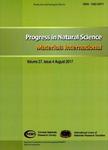Computer simulation on reliability of retention index with FDG-PET and optimization of dual-time-point imaging protocol
Computer simulation on reliability of retention index with FDG–PET and optimization of dual-time-point imaging protocol作者机构:Department of Biomedical Engineering Tsinghua University Room B209 Building of Medical Science Beijing 100084 China School of Information Technologies University of Sydney NSW 2006 Australia Department of Electronic and Information Engineering Hong Kong Polytechnic University Hong Kong
出 版 物:《Progress in Natural Science:Materials International》 (自然科学进展·国际材料(英文))
年 卷 期:2008年第18卷第8期
页 面:931-937页
核心收录:
学科分类:0810[工学-信息与通信工程] 08[工学] 0805[工学-材料科学与工程(可授工学、理学学位)] 081001[工学-通信与信息系统] 0702[理学-物理学]
基 金:the National Natural Science Foundation of China (Grant Nos. 60331010,60571013, and 30670577) the National Basic Research Program of China (Grant No. 2006CB705700) the Tsing-hua-Yue-Yuen Medical Science Foundation the ARC and PolyU/UGC Grants the Australia-China Special Fund of the Australian International Science Linkage(Grant No. CH050131)
主 题:Reliability Retention index PET (positron emission tomography) Simulation ROC (receiver operating characteristic)
摘 要:The inherent noise in positron emission tomography (PET) leads to the instability of quantitative indicators, which may affect the diagnostic accuracy for differentiating malignant and benign lesions in the management of lung cancer. In this paper, the reliability of retention index (RI) is systematically investigated by using computer simulation for the dual-time-point imaging protocol. The area under the receiver operating characteristic (ROC) curve is used to evaluate the optimal protocol. Results demonstrate that the reliability of RI is affected by several factors including noise level, lesion type, and imaging schedule. The RIs with small absolute values suffer from worse reliability than those larger ones. The results of ROC curves show that over delayed second scan cannot help to improve the diagnostic performance further, while an early first scan is expected. The method of optimization based on ROC analysis can be easily extended to comprise as many lesions as possible.



